Used 2017 ford f
Bạn đang xem: Used 2017 ford f
Almost everyone needs a truck a few times a year. Some people even buy them for those few occasions, then tolerate their size and fuel economy for the sake of image. But the Raptor makes a strong case for ignoring its even greater size (6.4 inches wider and 1.3 inches taller than a conventional F-150 4x4 SuperCrew) and thirstiness (16 mpg versus 19 mpg combined with the lower-output 3.5-liter V-6) by balancing those burdens with virtues like, say, the ability to fly, land gracefully, and drive home. Try that in any other three-ton vehicle without wings. Its purposeful looks, which show off Fox remote-reservoir dampers under huge fenders, don"t hurt, either. That it does all this without any hint of brodozer foolishness further increases its appeal.
Though its payload and tow ratings are compromised relative to a conventional F-150"s, there"s enough functional pickup here to suit most needs. Our Raptor"s 8000-pound tow rating is 2700 pounds lower than that of the equivalent F-150 4x4 SuperCrew equipped with the 375-hp EcoBoost 3.5-liter V-6 and 10-speed automatic. The Raptor"s 1200-pound payload capacity is also 830 pounds lower than that truck"s. Its soft, long-travel suspension sags under the tongue weight imposed by a 5000-pound car trailer. When we towed with a bed full of spare parts and tools, its nose pointed skyward and the steering went light and loose in a way a normal F-150"s wouldn"t. Nose-in-the-air stance aside, the truck capably yanks around two and a half tons of weekend fun thanks to the EcoBoost"s 510 pound-feet of torque and the 10-speed automatic"s towing calibration. And if you"re not towing all the time, maybe looking at the clouds when you do isn"t a deal breaker.
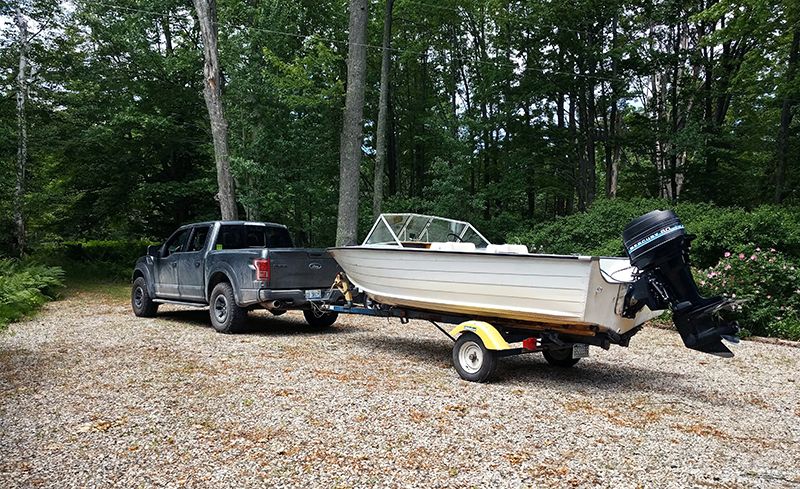
It might not be a towing champ, but the Raptor handled all our largely light-duty needs.
Greg Pajo|Car and Driver
Heavily outfitted, our 2017 Raptor 4x4 SuperCrew tallied $64,800 (base price $53,140). Standard equipment includes the 450-hp twin-turbocharged 3.5-liter V-6, 10-speed automatic with paddle shifters, and 4.10:1 electronically controlled locking rear differential. Our big-ticket option was the $9345 equipment group 802A, which adds the Torsen front differential, Sync 3 infotainment system, a trailer-brake controller, remote start, and more. We also opted for the $1165 17-inch forged-aluminum beadlock-capable wheels, $495 spray-in bedliner, and $375 tailgate step for easier access to that lofty bed. The heated steering wheel added $155; heated rear seats were $125.
It probably won"t shock you to learn that we warmed quickly to the Raptor"s torque. Sprayed with snow or gravel—the Raptor doesn"t discriminate—the roads around C/D headquarters are forever scarred. But we also came to appreciate the truck"s finer points. So reads the logbook: "No one does initial throttle response on a boosted engine better than Ford. Toe in just a millimeter or two and the 3.5-liter already feels awake, even before the turbos come online."
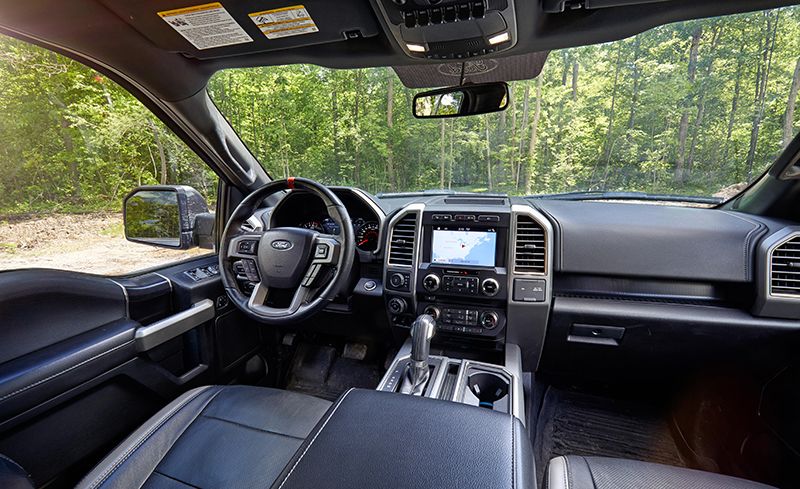
The 10-speed transmission"s merits were less obvious. It faded into the background during freeway cruising and skipped multiple gears at a time during downshifts, but it inelegantly slammed home aggressive second- and third-gear shifts during around-town driving. It"s not the smooth, responsive master of cog swapping that ZF"s eight-speed is in a Ram. And many of us gave up using its paddle shifters in any situation short of our most aggressive driving. Even then, picking the gear that appropriately matched cornering speed was a contest among as many as three candidates. Ten is just too many for toggling gears yourself.
The Raptor"s six drive modes—Normal, Sport, Weather, Mud/Sand, Baja, and Rock Crawl—do merit existence. Each mode determines things like the rear-differential setting and throttle and transmission mapping. Baja and Mud/Sand modes select high-range all-wheel drive automatically, while Rock Crawl prompts the driver to shift into low range. On its surface, the automatic shifting feels like a convenience measure, but in practice, it means the transfer case shifts with much more frequency than it might if doing so required more of the driver. Baja mode provides sufficient loosening of the reins to enjoy the Raptor"s 13.0 inches of front and 13.9 inches of rear wheel travel at our western Michigan proving grounds, also known as Silver Lake Sand Dunes. It was there that one driver was moved to write: "Experiencing this thing for the first time in its element will rearrange the minds of traditional truck folk."
The Raptor also rearranged its share of gravel roads in northern Michigan, where it proved far more comfortable at speed than a 5890-pound truck should be, easily luring drivers to link gravel corners in sideways glory slides. Again, the logbook attests to the truck"s potency: "If you have the nerve to forget about its considerable size and mass, this truck is planted enough to toss around like a big rally car."
At the Raptor"s 10,000-mile service, the dealer noticed oil on the back of our truck"s air filter. He changed the filter, and the problem—presumably a result of the positive crankcase ventilation system carrying oil into the intake—disappeared for good. We had four oil changes, which, combined with other routine maintenance and a four-wheel alignment, totaled $531. The 30,000-mile mark passed during a wet, salty February. About that time, our truck"s trailer-wire plug kept shorting and causing an unrelenting instrument-cluster warning as well as an audible bong every time the short occurred. And if you"re wondering how Ford deals with an issue like this—according to our dealer, it afflicted many F-150s—it"s to blow compressed air into the contaminated plug and wait for drier weather to arrive, which it did. In June. In the meantime, the bonging continued.
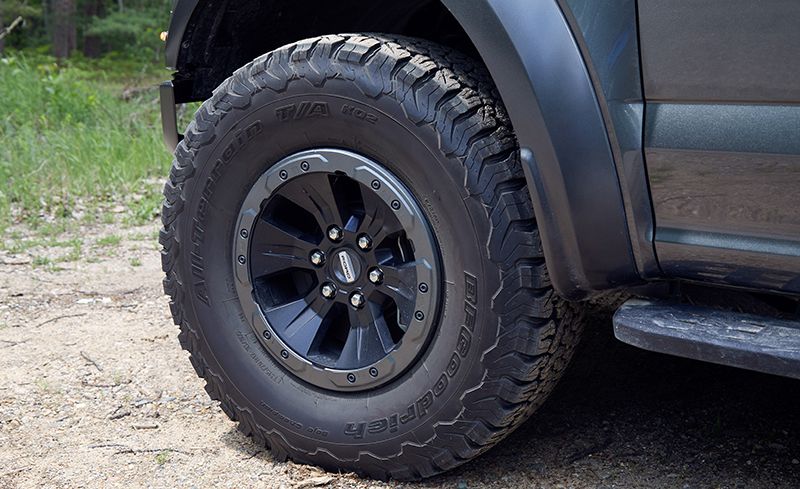
The BFGoodrich KO2 tires were quiet on the highway and tenacious on dirt and snow, but we had to replace them after less than 25,000 miles.
One of the Raptor"s greatest assets is its BFGoodrich All-Terrain T/A KO2 rubber, which allows it to perform off-road antics like those pictured here, adequately motivates it in the snow—we never ran winter tires because there aren"t any that fit—and helps it quietly go about daily duties. Our KO2s exhibited a wide latitude of ability but were not without issues. The first problem emerged—quite literally—at around 6500 miles when the right-front tire developed a conspicuous sidewall bulge and had to be replaced at a cost of $268. We replaced all four tires due to wear at 24,284 miles at a cost of $1040, which included mounting and balancing. Another tire problem arrived just as we were wrapping up our long-term test: We found the left front to be out of round, which we blamed for a violent 40-mph vibration. We replaced both front tires for $523 before returning the truck to Ford.
In May 2017, just after completing its 1000-mile break-in period, our Raptor vaporized the 60-mph mark in 5.5 seconds and bulldozed its way through the quarter-mile in 14.2 seconds at 97 mph. By June 2018, some 39,000 miles later, it added 0.5 second to both milestones and lost 4 mph from its trap speed. In the wrap-up test, the truck needed an additional 2.5 seconds to reach 100 mph. Some of the Raptor"s horsepower, it seems, had disappeared as quickly as seven BFGs and 2850 gallons of gas. Braking distance from 70 mph remained stable, stretching ever so slightly from 212 feet to 215. No one concerned themselves with the truck"s initial 0.69-g and final 0.70-g lateral-acceleration numbers.
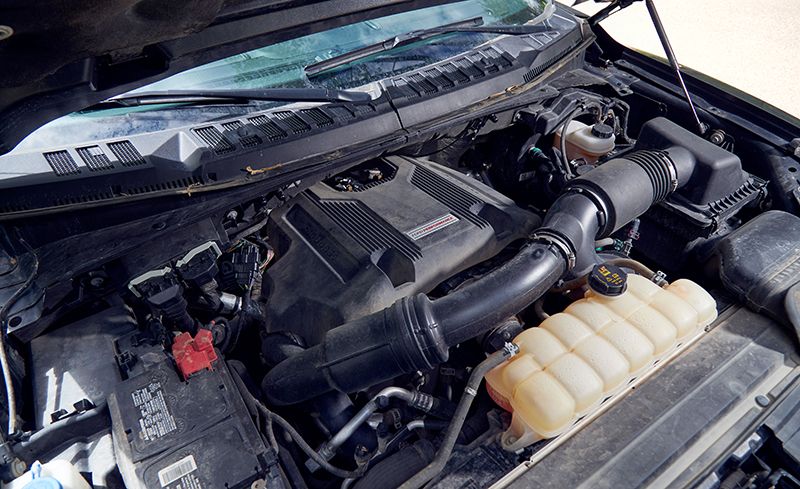
Raptors aren"t easy at the pump and ours was no exception. Its most dismal fuel economy, a mere 6 mpg, came when we were bombing around the sand dunes. And when towing a fully laden 22-foot, 3500-pound snowmobile trailer to northern Michigan, it didn"t do much better. With the engine running on heavy boost for much of the trip, the Raptor produced an OPEC-thrilling 8 mpg. Over the course of our loan, it averaged 14 mpg, 2 mpg below its 16-mpg EPA combined rating.
After hitting 40,000 miles, the Raptor began complaining with a noisy, ill-shifting transfer case. The dealer replaced a damaged shift fork, the clutch assembly, and a handful of other worn internal parts under warranty—a fix that took a week.
The Raptor is big, it"s not as quick as it once was, and it ate a costly drivetrain part at only 40,000 miles. Its virtues don"t blind us to its faults, but its dependable competence over the bulk of this test also can"t be ignored, particularly considering the way the Raptor tempted us to drive. That it was fantastic in the dirt, sand, and snow will surprise no one. But its effectiveness in everyday life—even when everyday life includes spurts of gravity-defying exuberance—astonished us. It"s functional enough to be both a usable truck and a pragmatic family vehicle. Perhaps the only thing it lacks is subtlety. Get yours in Magnetic Metallic like we did. No one will even notice.
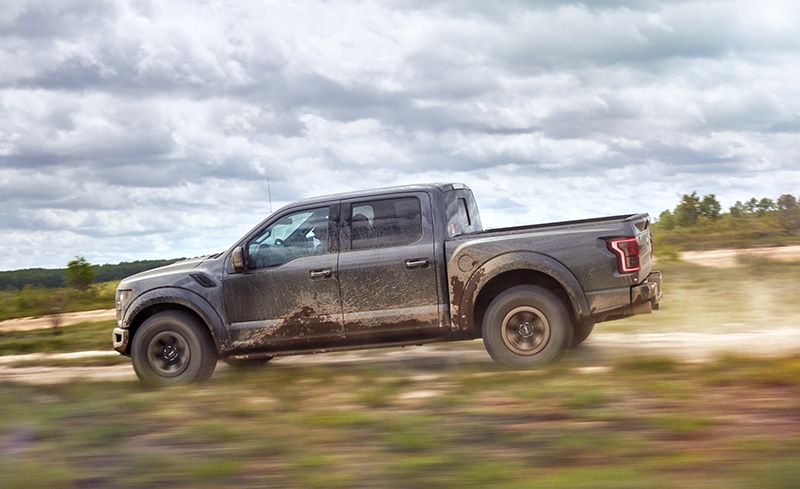
Rants & Raves
Got it stuck in a car wash. Too wide—one of its few faults. —K.C. Colwell
Its real trick is being able to fit a whole family in comfort, then drive right into the dunes for a day of hard-core wheeling. —Mike Sutton
So smooth off-road. The ease with which it covers rough ground at speed is intoxicating. It takes a serious custom rig to rival its abilities. —Mike Sutton
This is the Camaro ZL1 1LE of pickups—only it works better as a daily driver than the Camaro ever could. —Rich Ceppos
The Raptor is the only new vehicle in which I aim for potholes. —Alexander Stoklosa
It got smoked in a sand drag race by a pair of Duramax brodozers running paddle tires. —Mike Sutton
Every time I climb up into the Raptor, my Fitbit thinks I"ve gone up a flight of stairs. —Maxwell Mortimer
Brilliant combination of ride, handling, steering, powertrain muscle and refinement, off-road chops, and comfort. Remarkable! —Rich Ceppos
From the October 2018 issue
WHAT WE LIKE: The Raptor’s combination of style, utility, and rewarding driving continue to persuade us that a $65,000 three-ton truck—there, we said it—might just be the answer to the one-vehicle-to-do-it-all dilemma. Buyer’s Guide senior editor Rich Ceppos’s notes perhaps say it best: “Brilliant combination of ride, handling, steering, powertrain muscle/refinement, off-road chops, and comfort. Remarkable!” And he didn’t mention cargo hauling, five-adult seating, and, well, flying, which our Raptor is known to do on occasion.
Also, speed bumps: We’ve discovered why Oxford Companies property management installed them at C/D World Headquarters. It’s likely the Raptor is the first long-term vehicle to surpass the former 55-mph national speed limit through the parking lot.
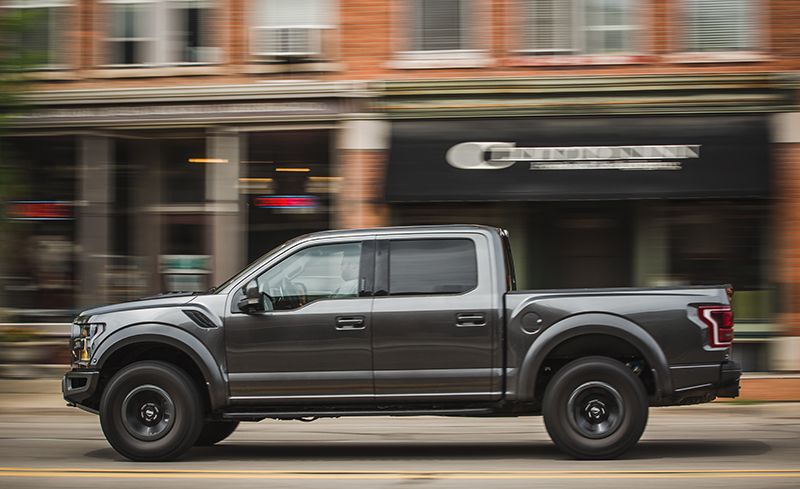
And although we’ve talked plenty about potholes in this space, it seems some editors are seeking them out under the pretense that in a Raptor/pothole encounter it’s the pothole that comes away worse for wear. So, yes, we continue to run things over with impunity, splash through puddles gracelessly, and perform juvenile acts without consequence. Then we take the kids to school.
WHAT WE DON’T LIKE: Some editors insist that the unavailability of a full-size bed is a deal breaker since their fishing poles won’t fit lengthwise in the payload area. Those are the same editors without children.
Ice isn’t the Raptor’s friend, either. Despite being reasonably competent in most varieties of snow, the BFGoodrich All-Terrain T/A KO2 tires do this truck no favors on ice. And there are no real winter-tire options in this LT315/70R-17 size. More than one of us also noticed that with half-worn rear rubber the Raptor becomes a lot more interesting to drive in the rain, sometimes trying to lead with its rear fenders rather than its front bumper—even at modest throttle openings. Thus far the stability control has prevailed, but as behind-the-wheel surprises go, a crossed-up Raptor ranks among the most eye-opening.
WHAT WENT WRONG: With Michigan’s liquid-winter hell in full force the Raptor developed a short in its trailer wiring, which triggered alternating “Trailer Attached” and “Trailer Disconnected” notifications accompanied by an audible bong. The short happened only in the wettest conditions, but when it did it was an unstoppable death spiral of noise and on-dash warnings. The dealer was no help, noting that this was a “known issue” among F-150s. Their solution? Clean out the trailer-wiring plug and ignore the warnings until the next time it’s cleaned. We haven’t had a problem since warm, dry weather arrived. In June.
The same dealer investigated our truck’s proximity-entry problem, in which the driver’s door refuses to open on the first try. Though irregular, it was persistent. But no problem could be identified.
We’re likely to need another two tires before the Raptor hits 40,000 miles, but despite being a relatively heavy consumer of black, round rubber objects and fuel, the truck has been dead reliable.
WHERE WE WENT: The Raptor made regular trips to northern Michigan for ice fishing over the winter, during which it also performed all manner of sideways antics. But it continues, most frequently, to be the vehicle of choice for commuting in and around Ann Arbor.
Months in Fleet: 15 months Current Mileage: 34,297 milesAverage Fuel Economy: 14 mpgFuel Tank Size: 36.0 gal Fuel Range: 500 milesService: $303 Normal Wear: $1040 Repair: $0 Damage and Destruction: $228
WHAT WE LIKE: Evidently the thing we like most about our Ford F-150 Raptor is spinning its odometer at ridiculous rates: Since its arrival in April of last year we’ve already ticked through 27,000 miles. This truck, on its surface, seems an unlikely choice for over-the-road travel, but it gets used often for that since it’s as capable of gently swallowing highway miles as it is of eating Michigan chuckholes. Despite its 34-inch-tall BFGoodrich rubber and refrigerator-in-a-wind-tunnel aero profile, the enormous rig sails down the road with the silence and serenity of an air-hockey puck. The arrival of Michigan winter coincided with the need for new rubber, leading to our discovery that, at full tread depth, the BFG All-Terrain T/A KO2 is a very reasonable winter tire. Even on hard-packed snow, the tires dig in and churn the white stuff into frozen pulp. Speaking of winter-specific features, this F-150’s remote-start function saves us the burden of being cold while we annoy our neighbors by roostertailing powder off the unplowed subdivision roads. There’s a lot to like here.
WHAT WE DON’T LIKE: Two editors complained about the truck’s periodic refusal to unlock its doors on the first tug of the handle when using its passive-entry function. Sometimes two or three yanks are required before it decides to allow access, but the problem is erratic so we’ve not yet seen the dealer for it. We’ve discovered that our SuperCrew Raptor, at 19.3 feet in length, is too long for smaller garages. We also recorded an egregious 8-mpg fill-up while towing a 22-foot, 3500-pound fully laden snowmobile trailer to northern Michigan. But that should be balanced against tanks of 11 and 13 mpg while towing a 5000-pound open car trailer to the same region. To date, our, ahem, “EcoBoosted” Raptor is averaging 14 mpg, 2 mpg shy of its EPA combined rating.
Xem thêm: Kia Con Buom Vang - Bài Hát Kìa Con Bướm Vàng ( Chế) Do Huy Thể Hiện
WHAT WENT WRONG: Our first-update worries about oil in the intake tract have largely abated; as of this writing, there has been no additional evidence. At 24,000 miles we swapped all four tires, a $1040 endeavor including mounting and balancing. A $150 routine oil change and inspection at 20,000 miles was exactly that and included replacement of both the cabin and engine air filters. Otherwise, we haven’t even added any fluids.
WHERE WE WENT: Multiple trips to northern Michigan are accounted for in the Raptor’s logbook. These are both recreational and utilitarian, including hauling snowmobiles for play or junk cars we’re no longer allowed to keep at the office. One nontowing adventure found the Raptor deep in the Upper Peninsula flirting with Wisconsin. The holidays included a trip to Franklin, Tennessee. Each of these trips bears out more of the Raptor’s personality, which is usually accompanied by a turbo-muffled growl that sounds something like, “Relax, I got this,” followed by a gross display of power and often some flying road surface. And thus far the truck does, in fact, have it.
Months in Fleet: 9 months Current Mileage: 27,107 milesAverage Fuel Economy: 14 mpg Fuel Tank Size: 36.0 gal Fuel Range: 500 miles Service: $216 Normal Wear: $1040 Repair: $0 Damage and Destruction: $228
WHAT WE LIKE: Who knew we’d enjoy ignoring curbs, chuckholes, road gators, and errant boulders this much? Truly, the breadth of the Ford F-150 Raptor’s capabilities is stupefying. As happy to haul the family comfortably to the theme park as it is to obliterate mud fields, the Raptor makes even the simplest errand a reason to exercise restraint. But only a little. At only 4000 miles our truck had already spent significant time in the Michigan sand dunes. It never wants for power, even in that situation. The ability to walk up the steepest dunes from nary a crawl at the bottom is telling of what’s under the hood. And with ample suspension travel, it will exceed freeway speed through the open stretches, no damage done. We found airing the tires down to 18 psi in the front and 15 psi in the rear gave it the necessary footprint to float through the silt without risking a busted bead. The chassis’s Baja or Mud/Sand modes each seem to do the trick, and the truck’s locking rear differential works great, provided the turns aren’t tight.
WHAT WE DON’T LIKE: There’s little to not like. Possibly the only regret we have is that Michigan doesn’t have bigger sand dunes and utterly lacks the vast stretches of desert where the Raptor can really shine. But, being professional whiners, we found a few more gripes. The 510 lb-ft of torque coupled with our collective heavy foot will mean a new set of tires by 25,000 or so miles. We once loaded a large cabinet in the bed and had to give the tailgate a shove to get it closed. The result was enough pressure on the tailgate that the electronic release wouldn’t, well, release. We lost some skin on a finger tripping the release manually, and that’s on us. But this is a truck. There should be a better solution.
WHAT WENT WRONG: At 6500 miles our Raptor’s right-front tire developed a bulge in the sidewall. It’s possible a senior staffer may have launched the Raptor over a curb in a desperate attempt to escape traffic. It’s also possible the tire fairy gave us a defective tire. That was a $228 hit. No one—especially not the fairy—is saying anything.
We also spent $66 on an uneventful oil change, tire rotation, and multipoint inspection at 10,000 miles. The dealer swapped the air filter at that service as well because the original was lightly oil-soaked—presumably a result of the engine’s exhaust-gas-recirculation system allowing oil into the intake. But at 16,864 miles there’s no oil in the new filter or in the intake. We’re keeping an eye on it.
WHERE WE WENT: Over its first 16,000-plus miles, the Raptor’s farthest journeys have been Michigan-based—three to the Silver Lake Sand Dunes for good thrashings and one to Hale for the Michigan Mud Jam, a festival of culture and aromas unlike any other. We even drove the big hoss down to Ohio once or twice, but nothing exciting ever happens there.
Months in Fleet: 5 months Current Mileage: 16,864 milesAverage Fuel Economy: 15 mpgFuel Tank Size: 36.0 gal Fuel Range: 540 milesService: $66 Normal Wear: $0 Repair: $0Damage and Destruction: $228
When it comes to traversing Michigan potholes, there are two strategies. Most folks employ the balanced-human approach: Plod through the minefield carefully, taking it easy in hopes nothing gets bent. The second tactic requires more, well, let’s call it commitment. Every vehicle has a safe speed at which it will fly right over the craters, occasionally skimming their edges but never dropping a wheel far enough below the surface to do damage. It’s the automotive equivalent of a supercross racer in the whoops. When perfectly executed, both are effective means to get home. Strategy two comes with the reward of getting there sooner and the risk of, say, removing an axle from the vehicle.
Until now, this was an actual dilemma.
Our long-term Ford F-150 Raptor SuperCrew, then, is a $64,800, 450-hp dilemma killer. That it tears a commercial-truck-sized hole in the atmosphere while completing a 14.2-second quarter-mile at 97 mph and hits 60 mph in only 5.5 seconds, well, those things are just gravy.
So, you see, owning a Raptor in Michigan is simply pragmatic. Here, the road shoulders are a burial ground for long-dead Caprices, Plymouths, Silverados, and, yes, F-150s that couldn’t hack the wet, freezing misery. What better way to celebrate potholes, frost heaves, and shweckled wheels than to embrace them with a truck unburdened by such concerns? We couldn’t think of one, so we ordered a Raptor to test for 40,000 miles.
Impulsiveness
Fortunately, every Raptor comes with the same wildly capable hardware: a twin-turbo 3.5-liter V-6, a 10-speed automatic transmission, BFGoodrich All-Terrain T/A KO2 tires, Fox dampers, and a penchant for inducing poor impulse control.
And what would a gratuitous truck be without a gratuitous options list? Ours is loaded with $11,660 in add-ons, starting with the $9345 Equipment Group 802A, which supplies a Torsen limited-slip front differential (a locking rear diff is standard), 360-degree cameras, remote start, dual-zone automatic climate control, Sync 3 infotainment, a trailer-brake controller and backup assist, and more. We then piled on these à la carte additions: 17-inch forged-aluminum wheels, a heated steering wheel, second-row heated seats, a tailgate step, and a spray-in bedliner. And, of course, ours is dark gray—Magnetic, in Ford-speak—with black wheels.
Outrageous Utility
Just for sport, we’ve begun lining up Michigan’s ever-sprouting potholes and smoothing them to cream with the Raptor’s ever-buttery bypass dampers. Emboldened by its prodigious amounts of wheel travel—13.0 inches in front and 13.9 at the rear—we’ve taken to charging through more than road imperfections, however. Periodically, we run through our local off-road park—sideways, of course—just to send the locals into a tailspin as the Raptor chews through dirt mounds and rooster tails every sand wash, spewing an unending stream of Michigan alfisols from all four tires. Did we mention its 510 lb-ft of torque?
It flies—and lands, even—with substantially more poise than any three-ton wingless vehicle should. It is also, by a wide margin, the most popular vehicle in our long-term fleet. And that’s a fleet that currently includes a Chevrolet Corvette Grand Sport, a Ford Shelby GT350, and a Porsche 718 Boxster S. Drawing weekend reservations months in advance, the big Ford is in as much demand as a $40 per night VRBO on Monaco’s Mirabeau corner.
It’s a machine that perfectly aligns your wants: “I might be middle-aged, but I still indulge the occasional airborne railroad crossing,” with your needs: “I have two dorky kids and a ton of crap to haul around.” On and on, it is the embodiment of outrageous—massive, coarse, rapid, and capable of eating curbs at freeway speeds. It is to subtlety what Charlie Sheen is to decorum. Yet, as an everyday vehicle, it’s also feature rich, stunningly comfortable, and remarkably easy to live with. The big goofball is perfectly happy to cruise the expressway in quiet, frost-heave pooh-poohing ease.
Big, Bad, Bold
Its corpulence doesn’t prevent it from being easy on the eyes. More than six inches wider than a standard F-150 and beefed up with flared fenders front and rear, the thing is a distinguished giant. It’s also fraught with styling that reveals its goods, like holes in the front bumper to show off its beefy suspension pieces and the 3.0-inch-diameter dampers that help it stand proud of Michigan’s countless volumes of matter-of-fact pickups.
But beneath all its desert-hammering skin, there’s still a real, usable four-door pickup capable of towing an 8000-pound trailer, hauling 1200 pounds in its bed, and taking those dorks to school. This duality is what makes the Raptor so appealing. We’re looking forward to the next 35,000 miles. (Bonus: The odometer doesn’t measure distance traveled off the ground.)
Thus far, about 5000 miles in, we’ve discovered only three faults: Ten is too many gears. It’s too wide for at least one local car wash. At full throttle, it honks like a Pontiac Sunbird in the Holland Tunnel.
But, good Lord, nothing has ever cared less about potholes.
Months in Fleet: 2 months Current Mileage: 5113 milesAverage Fuel Economy: 14 mpgFuel Tank Size: 36.0 gal Fuel Range: 500 milesService: $0 Normal Wear: $0 Repair: $0
Specifications
VEHICLE TYPE: front-engine, rear/all-wheel-drive, 5-passenger, 4-door pickup
PRICE AS TESTED: $64,800 (base price: $53,140)
ENGINE TYPE: twin-turbocharged and intercooled DOHC 24-valve V-6, aluminum block and heads, port and direct fuel injection
Displacement: 213 cu in, 3496 ccPower: 450 hp
3500 rpm
TRANSMISSION: 10-speed automatic with manual shifting mode
DIMENSIONSWheelbase: 146.0 inLength: 231.9 inWidth: 86.3 inHeight: 78.5 inPassenger volume: 136 cu ftCurb weight: 5890 lb
PERFORMANCE (NEW)Zero to 60 mph: 5.5 secZero to 100 mph: 15.4 secRolling start, 5-60 mph: 6.1 secTop gear, 30-50 mph: 4.1 secTop gear, 50-70 mph: 4.2 secStanding ¼-mile: 14.2 sec
97 mphTop speed (governor limited): 108 mphBraking, 70-0 mph: 212 ftRoadholding, 300-ft-dia skidpad: 0.69 g
PERFORMANCE (40,000 MILES)Zero to 60 mph: 6.0 secZero to 100 mph: 17.9 secRolling start, 5-60 mph: 6.5 secTop gear, 30-50 mph: 4.4 secTop gear, 50-70 mph: 4.5 secStanding ¼-mile: 14.7 sec
93 mphTop speed (governor limited): 108 mphBraking, 70-0 mph: 215 ftRoadholding, 300-ft-dia skidpad: 0.70 g
C/D FUEL ECONOMYObserved: 14 mpgUnscheduled oil additions: 0 qt
WARRANTY3 years/36,000 miles bumper to bumper;5 years/60,000 miles powertrain;5 years/unlimited miles corrosion protection;5 years/60,000 miles roadside assistance
This content is imported from OpenWeb. You may be able to find the same content in another format, or you may be able to find more information, at their web site.











